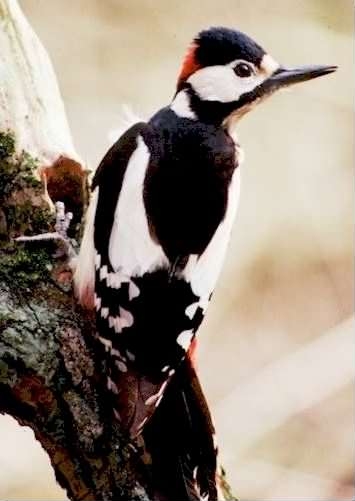

Photo ©2001 Pat O'Reilly
Fishing in Wales
Larger video
Larger video
 |
 Photo ©2001 Pat O'Reilly Fishing in Wales |
Larger video |
| Videos ©2014– |
Larger video |
Great Spotted Woodpecker - Dendrocopos major
Family - Picidae
Not quite the largest of our native woodpecker species it has boldly pied plumage with large white wing patches. Like the Lesser Spotted Woodpecker it has a white chest and cheeks, with a black crown. Males have a red patch to the neck which is absent in females and young birds who may have a pinkish neck patch. In adults both sexes have a red tinged rump. It is 23–26cm (9.1–10.2in) long, with a 38–44cm (15–17in) wingspan. The most widespread and abundant of the Spotted Woodpeckers it's found throughout Britain, Scandinavia, Europe and northern Asia, in coniferous or mixed woodland and forest, parks, orchards and sometimes in winter in large gardens. It is not considered a threatened species by the IUCN, being widely distributed and quite common.
Commonly heard and rarely seen despite its bright plumage, it most often announces its presence by a loud drumming sound as it searches for food or excavates its nest hole in a rotten trunk or branch. Nesting in chambers with an elliptical entrance bored by both the sexes in rotting tree trunks, they lay 4–7 glossy white eggs in May, incubating them for about 16 days, fledging after about 20 days. It feeds on the grubs of wood boring insects, spiders, seeds, berries, nuts and occasionally other nestling birds. Small populations exist on the Canary Isles, Corsica, Sardinia, Sicily, Northern Turkey, Morocco, Algeria and Tunisia. About 15 subspecies have been described, each differing slightly in size, bill and colouration, but differentiation between these subspecies is difficult. Typically northern species are larger with shorter, stouter bills and whiter undersides. The Great Spotted Woodpecker has apparently recently re–colonised Ireland, where it has been extinct since the eighteenth century. Although feeding their young largely on insects and spiders, great spotted woodpeckers are notorious for taking the eggs and young of other birds with Blue Tits, Great Tits, Coal Tits and Nuthatches all being victims. However from our own observations in Brickfields Country Park we have seen Great Spotted Woodpeckers co–existing in the same tree with Nuthatches with both successfully raising their broods. Brickfields Country Park generally supports 2–3 breeding pairs of Great Spotted Woodpeckers.
Site design ©1999– Brickfields Country Park - Privacy -